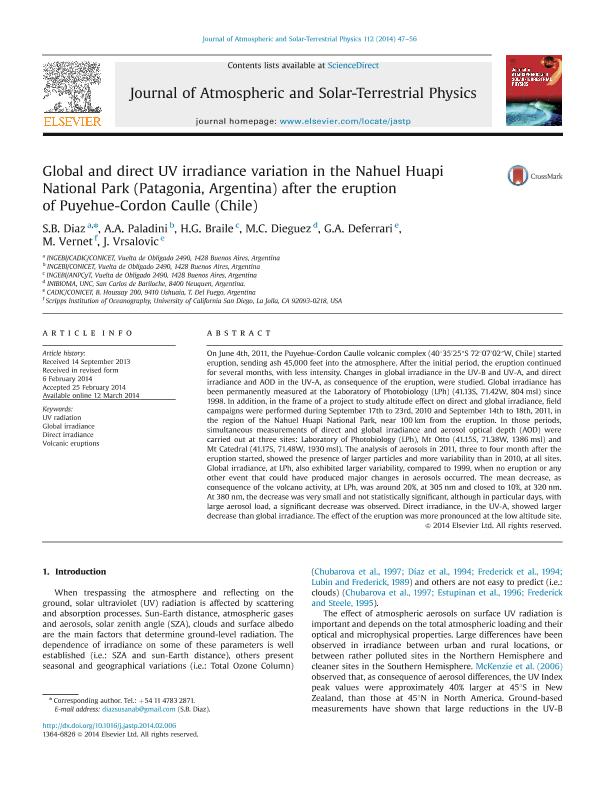Artículo
Global and Direct UV Irradiance Variation in the Nahuel Huapi National Park (Patagonia, Argentina) After the Eruption of Puyehue- Cordon Caulle (Chile)
Diaz, Susana Beatriz ; Paladini, Alejandro Alberto
; Paladini, Alejandro Alberto ; Braile, H.G.; Dieguez, Maria del Carmen
; Braile, H.G.; Dieguez, Maria del Carmen ; Deferrari, Guillermo Alejandro
; Deferrari, Guillermo Alejandro ; Vernet, María; Vrsalovich, J.
; Vernet, María; Vrsalovich, J.
 ; Paladini, Alejandro Alberto
; Paladini, Alejandro Alberto ; Braile, H.G.; Dieguez, Maria del Carmen
; Braile, H.G.; Dieguez, Maria del Carmen ; Deferrari, Guillermo Alejandro
; Deferrari, Guillermo Alejandro ; Vernet, María; Vrsalovich, J.
; Vernet, María; Vrsalovich, J.
Fecha de publicación:
25/02/2014
Editorial:
Elsevier
Revista:
Journal Of Atmospheric And Solar-terrestrial Physics
ISSN:
1364-6826
Idioma:
Inglés
Tipo de recurso:
Artículo publicado
Clasificación temática:
Resumen
On June 4th, 2011, the Puyehue-Cordon Caulle volcanic complex (40ª35´25′′S 72ª07´02′′W, Chile) started eruption, sending ash 45,000 feet into the atmosphere. After the initial period, the eruption continued for several months, with less intensity. Changes in global irradiance in the UV-B and UV-A, and direct irradiance and AOD in the UV-A, as consequence of the eruption, were studied. Global irradiance has been permanently measured at the Laboratory of Photobiology (LPh) (41.13S, 71.42W, 804 msl) since 1998. In addition, in the frame of a project to study altitude effect on direct and global irradiance, field campaigns were performed during September 17th to 23rd, 2010 and September 14th to 18th, 2011, in the region of the Nahuel Huapi National Park, near 100 km from the eruption. In those periods, simultaneous measurements of direct and global irradiance and aerosol optical depth (AOD) were carried out at three sites: Laboratory of Photobiology (LPh), Mt Otto (41.15S, 71.38W, 1386 msl) and Mt Catedral (41.17S, 71.48W, 1930 msl). The analysis of aerosols in 2011, three to four month after the eruption started, showed the presence of larger particles and more variability than in 2010, at all sites. Global irradiance, at LPh, also exhibited larger variability, compared to 1999, when no eruption or any other event that could have produced major changes in aerosols occurred. The mean decrease, as consequence of the volcano activity, at LPh, was around 20%, at 305 nm and closed to 10%, at 320 nm. At 380 nm, the decrease was very small and not statistically significant, although in particular days, with large aerosol load, a significant decrease was observed. Direct irradiance, in the UV-A, showed larger decrease than global irradiance. The effect of the eruption was more pronounced at the low altitude site.
Archivos asociados
Licencia
Identificadores
Colecciones
Articulos(CADIC)
Articulos de CENTRO AUSTRAL DE INVESTIGACIONES CIENTIFICAS
Articulos de CENTRO AUSTRAL DE INVESTIGACIONES CIENTIFICAS
Articulos(INGEBI)
Articulos de INST.DE INVEST.EN ING.GENETICA Y BIOL.MOLECULAR "DR. HECTOR N TORRES"
Articulos de INST.DE INVEST.EN ING.GENETICA Y BIOL.MOLECULAR "DR. HECTOR N TORRES"
Articulos(INIBIOMA)
Articulos de INST. DE INVEST.EN BIODIVERSIDAD Y MEDIOAMBIENTE
Articulos de INST. DE INVEST.EN BIODIVERSIDAD Y MEDIOAMBIENTE
Citación
Diaz, Susana Beatriz; Paladini, Alejandro Alberto; Braile, H.G.; Dieguez, Maria del Carmen; Deferrari, Guillermo Alejandro; et al.; Global and Direct UV Irradiance Variation in the Nahuel Huapi National Park (Patagonia, Argentina) After the Eruption of Puyehue- Cordon Caulle (Chile); Elsevier; Journal Of Atmospheric And Solar-terrestrial Physics; 112; (2014); 25-2-2014; 47-56
Compartir
Altmétricas



